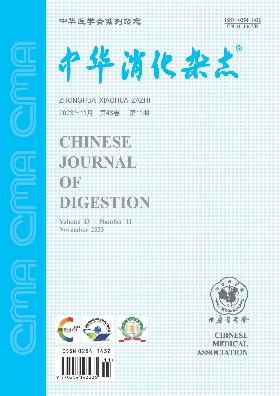Clinical and pathological characteristics of 107 esophageal neuroendocrine carcinoma
引用次数: 0
Abstract
Objective To investigate the clinical and pathological features of patients with esophageal neuroendocrine carcinoma (ENEC). Methods From January 2011 to November 2018, 107 patients with pathologically confirmed ENEC were enrolled at the First Affiliated Hospital of Zhengzhou University. The clinical manifestation, tumor location, tumor size, clinical pathological classification and immunohistochemical markers were analyzed. Statistical description was used for measurement data analysis, and chi-square test was performed for classification data analysis. Results Among 107 patients with ENEC, feeling obstruction during eating was the most common initial symptom, accounting for 63.6%(68/107); followed by chest and back pain, accounting for 13.1%(14/107). About 60.7%(65/107) patients were diagnosed by biopsy under endoscopy and 39.3% (42/107) patients were confirmed by pathological diagnosis after surgery. The proportion of tumor located in the upper thoracic esophagus and middle and lower thoracic segments was 13.1%(14/107), 45.8%(49/107) and 41.1%(44/107), respectively. The length of tumor was 0.7 cm to 9.0 cm, and the median was 2.5 cm. Among them, 57.0%(61/107) were less than 2.5 cm and 43.0%(46/107) were over 2.5 cm. Among 107 patients, 50 (46.7%) patients were ulcerative type, 32 (29.9%) patients were medullary type, 16 (15.0%) patients were mushroom type and nine (8.4%) patients were protrude type. Among 107 patients, 96 (89.7%) patients were pure neuroendocrine carcinoma (P-NEC; including 95 small cell types, one large cell type); 11 (10.3%) patients were mixed neuroendocrine carcinoma (M-NEC; including nine small cell carcinoma mixed with squamous cell carcinoma, two small cell carcinoma mixed with adenocarcinoma). The positive rates of synaptophysin, CD56 and chromogranin A were 99.0%(104/105), 98.0%(100/102) and 31.5%(17/54), respectively. Ki-67 proliferation index of 47.7% tumors (51/107) was between 90% and 100%. P-NEC with the maximum diameter over 2.5 cm accounting for 42.1%(45/107), and M-NEC accounting for 0.9%(1/107). The maximum diameter of P-NEC group was larger than that of M-NEC group, and the difference was statistically significant (χ2=4.311, P=0.038). Conclusions ENEC is a kind of highly aggressive malignant tumor with nonspecific manifestations. The diagnosis mainly depends on histopathology and immunohistochemistry. Key words: Carcinoma, neuroendocrine; Esophagus; Immunohistochemistry; Pathology; Clinic107例食管神经内分泌癌的临床与病理特点
目的探讨食管神经内分泌癌(ENEC)的临床及病理特点。方法选取2011年1月至2018年11月郑州大学第一附属医院经病理证实的ENEC患者107例。分析两组患者的临床表现、肿瘤位置、肿瘤大小、临床病理分型及免疫组织化学指标。计量资料分析采用统计描述,分类资料分析采用卡方检验。结果107例ENEC患者中,进食时感觉梗阻是最常见的首发症状,占63.6%(68/107);其次是胸背疼痛,占13.1%(14/107)。60.7%(65/107)患者在内镜下活检确诊,39.3%(42/107)患者术后病理确诊。肿瘤位于胸上段食道、胸中段和下段的比例分别为13.1%(14/107)、45.8%(49/107)和41.1%(44/107)。肿瘤长度0.7 ~ 9.0 cm,中位2.5 cm。其中57.0%(61/107)小于2.5 cm, 43.0%(46/107)大于2.5 cm。其中溃疡型50例(46.7%),髓样型32例(29.9%),蘑菇型16例(15.0%),突出型9例(8.4%)。107例患者中,96例(89.7%)为纯神经内分泌癌(P-NEC;包括95个小牢房类型,1个大牢房类型);混合性神经内分泌癌11例(10.3%);其中9例小细胞癌合并鳞状细胞癌,2例小细胞癌合并腺癌。synaptophysin、CD56和chromogranin A的阳性率分别为99.0%(104/105)、98.0%(100/102)和31.5%(17/54)。47.7%(51/107)肿瘤的Ki-67增殖指数在90% ~ 100%之间。最大直径大于2.5 cm的P-NEC占42.1%(45/107),M-NEC占0.9%(1/107)。P- nec组最大直径大于M-NEC组,差异有统计学意义(χ2=4.311, P=0.038)。结论ENEC是一种非特异性的高侵袭性恶性肿瘤。诊断主要依靠组织病理学和免疫组织化学。关键词:肿瘤;神经内分泌;食道;免疫组织化学;病理学;诊所
本文章由计算机程序翻译,如有差异,请以英文原文为准。
求助全文
约1分钟内获得全文
求助全文

 求助内容:
求助内容: 应助结果提醒方式:
应助结果提醒方式:


